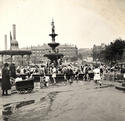 At the outbreak of the First World War Glasgow legendarily had more open spaces (totalling over 1,500 acres) than any other European city apart from Paris. They were well-maintained and policed, reflecting the generosity of donors and municipal prosperity. Immediately after the War, parks were often chosen sites for memorials, those chilling reminders of the human sacrifice on the battlefields. There are fine examples in both Kelvingrove and Victoria Park.
At the outbreak of the First World War Glasgow legendarily had more open spaces (totalling over 1,500 acres) than any other European city apart from Paris. They were well-maintained and policed, reflecting the generosity of donors and municipal prosperity. Immediately after the War, parks were often chosen sites for memorials, those chilling reminders of the human sacrifice on the battlefields. There are fine examples in both Kelvingrove and Victoria Park.
 In the bleak years of the industrial depression, the city's priorities shifted towards the urgent need to improve housing and away from the care of this inheritance. There was even a suggestion in 1919 that some of the parks could be taken over for housing development. Nevertheless the parks endured, less well maintained and more dangerous, particularly at night, than they had been in the past. Unlike the second half of the 19th century, no new parks were gifted to the city or created during these difficult years. As the world economy struggled out of recession in the late 1930s, Bellahouston Park was chosen as the site for the Empire Exhibition of 1938. Only the Palace of Art survives from this showcase for Scottish science and industry.
In the bleak years of the industrial depression, the city's priorities shifted towards the urgent need to improve housing and away from the care of this inheritance. There was even a suggestion in 1919 that some of the parks could be taken over for housing development. Nevertheless the parks endured, less well maintained and more dangerous, particularly at night, than they had been in the past. Unlike the second half of the 19th century, no new parks were gifted to the city or created during these difficult years. As the world economy struggled out of recession in the late 1930s, Bellahouston Park was chosen as the site for the Empire Exhibition of 1938. Only the Palace of Art survives from this showcase for Scottish science and industry.
 The Second World War took a greater toll. Allotment grounds were created in most of the city's parks as part of the Dig for Victory Campaign and gardens were neglected. By 1945, like so much else, they were a sorry reminder of their former glory. Determined efforts with scant resources were made to restore them under the direction of visionary superintendents of the Parks Department.
The Second World War took a greater toll. Allotment grounds were created in most of the city's parks as part of the Dig for Victory Campaign and gardens were neglected. By 1945, like so much else, they were a sorry reminder of their former glory. Determined efforts with scant resources were made to restore them under the direction of visionary superintendents of the Parks Department.